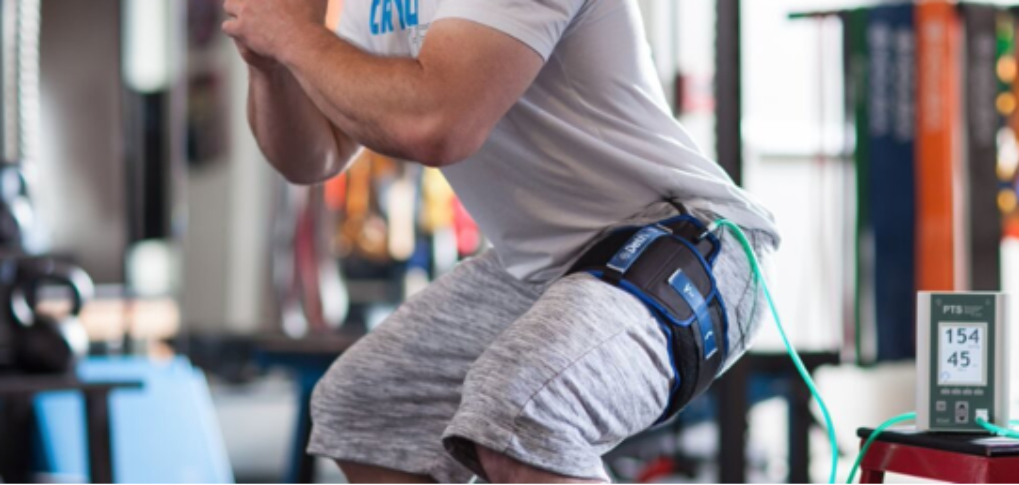What is Blood Flow Restriction or BFR training?
Blood Flow Restriction (BFR) training involves using a band, similar to a tourniquet, or a blood pressure cuff that you can use in your Physical Therapists office to partially restrict blood flow while working out. By limiting the blood flow during the workout, you can work out at a similar intensity with less stress or resistance on the limb but still benefit from muscle growth. BFR also enhances endurance and assists in injury rehabilitation. BFR has been researched since the early 2000s, so it is not something that is brand new but has not been used in the everyday rehab setting until recently.
How does BFR training work?
A band is placed on your arms below the shoulder to limit the blood returning to your heart (venous return) while allowing arterial blood to continue to circulate into the muscles. Placing the band below your hip on your thigh is the technique to perform BFR on your legs and lower body.
Typically, using heavy weightlifting without BFR, you have to work out using the resistance of 60-70% of your one-rep max for your muscles to grow bigger and stronger. Training resistance of this caliber causes muscles to become hypoxic (lower oxygen levels), leading to the production of metabolites. Metabolites serve as cellular signals to the muscles to grow bigger and stronger.
By using BFR, you can workout with less weight and get a faster metabolic response (the production of metabolites) without the wear and tear on your muscles from regular training.
Bodybuilders have been using this technique for quite some time. From the research out there, one of the main benefits of BFR is increasing strength and muscle mass using relatively light weights. A typical BFR protocol involves lifting between 20% – 40% of your one-rep maximum (1RM), with one set of 30 repetitions followed by three sets of 15 repetitions each, with 30 to 60 seconds of rest in between. The muscle gains from this typical protocol are similar to the gains you would experience while performing a high-intensity workout.
There are a few populations that benefit from BFR training.
- The serious athlete benefits from BFR as a way to add sets after they have maxed out their typical workout, giving them an extra boost to their training. The push nowadays is to not be completely passive on recovery days. Using BFR as an “active recovery day” allows the athlete to continue to see gains on non-training days, where they may not be actively working out.
- Another population that benefits from BFR are those that are rehabbing an injury. Whether it be an ACL injury, tendinitis, or post-operative knee surgery, BFR gives you enhanced metabolic training effects without putting as much mechanical stress on a healing muscle or joint. Also, BFR has been used pre-surgery to help reduce muscular loss post-surgery, which is very common in orthopedic surgeries.
- Elderly patients who need to get stronger to maintain independence after an illness or may have generalized weakness can also benefit from BFR training. It allows the patient to maximize muscle strength and growth using low weights and low impact. It can be used without the need for large amounts of space or resistance equipment.
Overall, BFR is useful in many populations, which makes it even more versatile. For example, non-weight bearing patients with fractures can use BFR to prevent any further loss of muscle due to lack of activity or even with elderly patients who are unsteady on their feet due to balance and strength issues. The BFR training sessions are typically short, allowing you to get in a full workout in a shorter amount of time.
So what’s the next step for trying Blood Flow Restriction training?
Find a training professional certified in BFR before you try it on your own. BFR is safe when done with the proper equipment and under the supervision of a trained and certified individual. If done improperly on your own, it could lead to nerve or muscle damage and an increased risk of forming blood clots. Most certified professionals will work with you for 6-8 sessions to fine-tune your routine before allowing you to use BFR cuffs independently if desired.
Contraindications for BFR training are as follows: a history of blood clots (deep vein thrombosis or pulmonary embolism), heart disease, vascular disease, hypertension, poor blood flow, or anyone pregnant, as this may increase your risk for stroke.
Give this form of exercise a try, but do so under the supervision of a certified and trained individual. You will be amazed at how quickly you notice muscular changes!


Very interesting. My PT tried it on me last week. Was very different. I have tendon tears in my glutes and hamstrings. No idea why. Was used to swimming 1ml to 1 and quarter ml before pandemic started. Things changed having to stay home and no pool. Started back yesterday. Have to build back up
I tore a calf [gastro] 3 months ago, working on a comeback to the court… can you please send me ideas to incorporate BFR with my trainer?